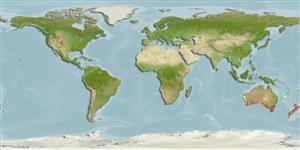Environment: milieu / climate zone / profondeur / distribution range
Écologie
marin; saumâtre démersal; profondeur 0 - 100 m (Ref. 33839). Subtropical
Eastern Indian Ocean and Southwest Pacific: south coast of Australia; New Zealand (Ref. 5755).
Taille / Poids / Âge
Maturité: Lm ? range ? - ? cm
Max length : 45.0 cm TL mâle / non sexé; (Ref. 9563)
Description synthétique
Clés d'identification | Morphologie | Morphométrie
Rayons mous dorsaux (Total) : 56 - 69; Rayons mous anaux: 40 - 50. Body deep (47-60% SL). Snout slightly extended into fleshy process projecting more or less in front of oblique mouth. Scales very small, rather firmly attached; cycloid on both sides, covering head except well anteriorly. Caudal fin rays 14 -17 (Ref. 33839).
Body shape (shape guide): short and / or deep; Cross section: compressed.
Common on silty sand substrates from estuaries and inshore waters down to 100 m depth. Juveniles occasionally entering rivers.
Life cycle and mating behavior
Maturité | Reproduction | Frai | Œufs | Fécondité | Larves
Kailola, P.J., M.J. Williams, P.C. Stewart, R.E. Reichelt, A. McNee and C. Grieve, 1993. Australian fisheries resources. Bureau of Resource Sciences, Canberra, Australia. 422 p. (Ref. 6390)
Statut dans la liste rouge de l'IUCN (Ref. 130435: Version 2025-1)
Menace pour l'homme
Harmless
Utilisations par l'homme
Pêcheries: commercial; Aquaculture: expérimental
Outils
Articles particuliers
Télécharger en XML
Sources Internet
Estimates based on models
Preferred temperature (Réf.
123201): 11.9 - 18.3, mean 16.6 °C (based on 248 cells).
Phylogenetic diversity index (Réf.
82804): PD
50 = 0.5625 [Uniqueness, from 0.5 = low to 2.0 = high].
Bayesian length-weight: a=0.01820 (0.00790 - 0.04194), b=2.97 (2.76 - 3.18), in cm total length, based on LWR estimates for this (Sub)family-body shape (Ref.
93245).
Niveau trophique (Réf.
69278): 3.1 ±0.3 se; based on size and trophs of closest relatives
Résilience (Réf.
120179): Milieu, temps minimum de doublement de population : 1,4 à 4,4 années (K=0.2; tmax=10).
Fishing Vulnerability (Ref.
59153): Moderate vulnerability (35 of 100).
🛈
Nutrients (Ref.
124155): Calcium = 107 [44, 243] mg/100g; Iron = 1.08 [0.50, 2.26] mg/100g; Protein = 18.1 [16.6, 19.6] %; Omega3 = 0.212 [0.104, 0.434] g/100g; Selenium = 38.1 [17.5, 93.5] μg/100g; VitaminA = 3.74 [0.87, 17.31] μg/100g; Zinc = 0.728 [0.467, 1.155] mg/100g (wet weight);
